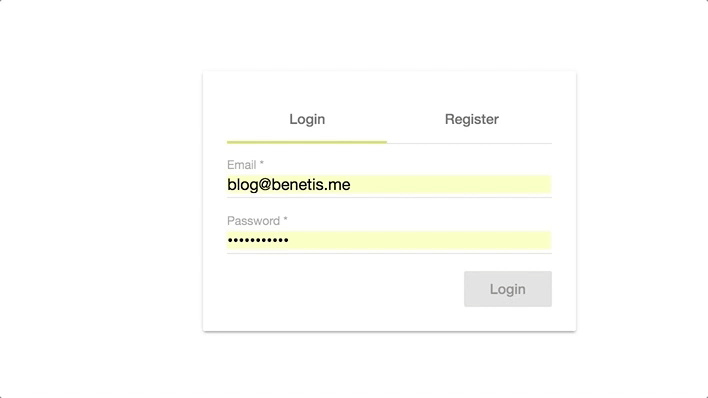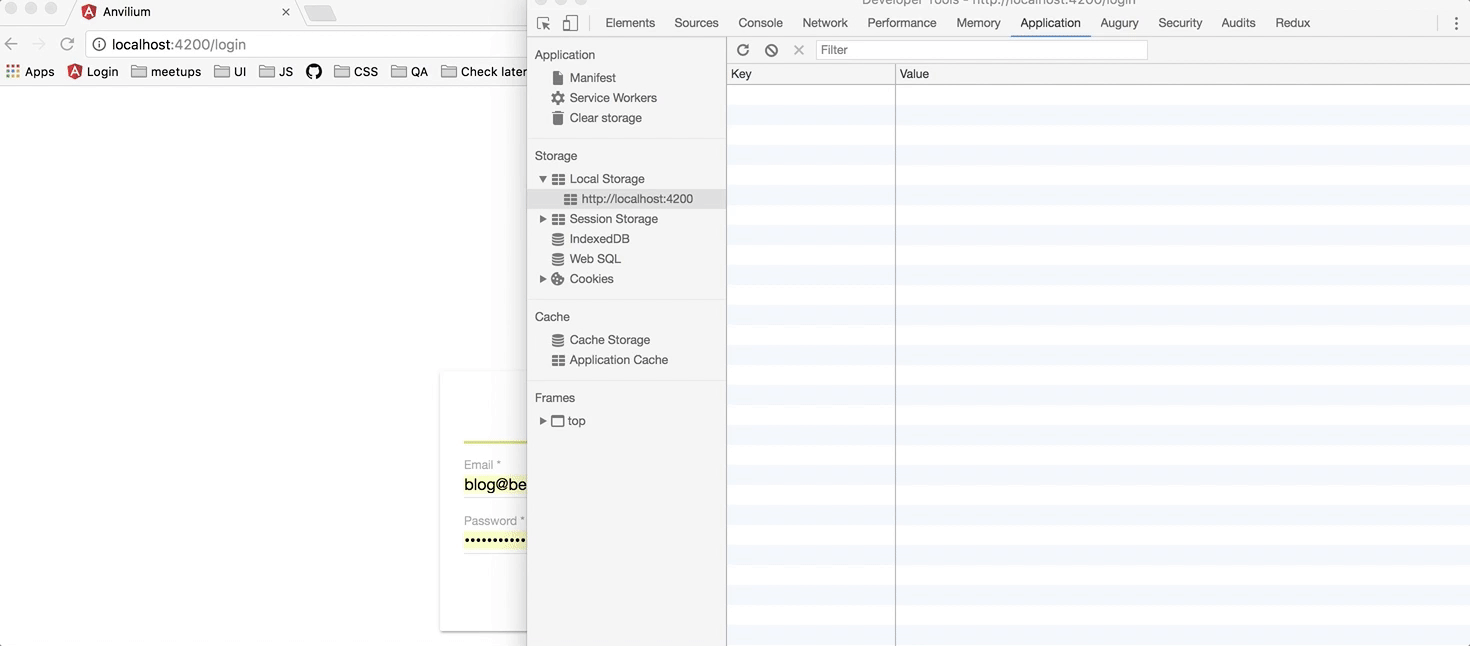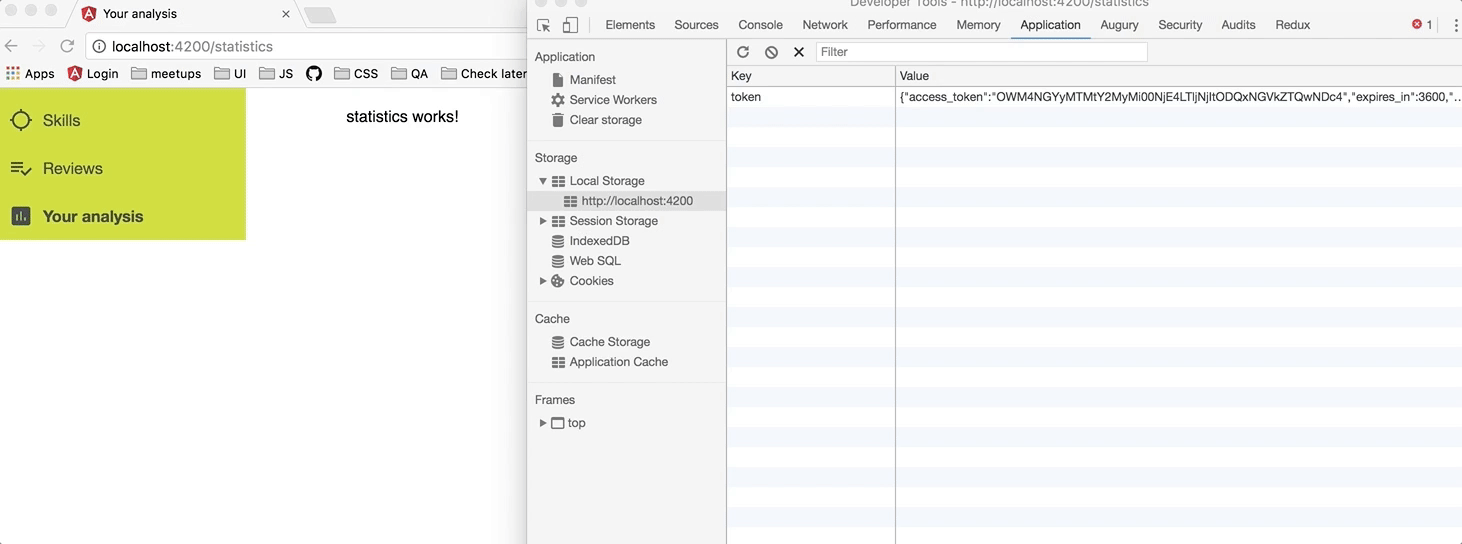Introduction
This is part two of Authentication in Angular series. This one is about building authentication part to handle OAuth calls for us. You can find first post here: https://benetis.me/posts/angular-authentication/
We will be using redux with our angular project to help us handle side effects. https://github.com/ngrx/store
Our setup - angular-cli 1.0 + Angular4 (Angular 4.1)
Aims
- After user clicks login - we need to call OAuth endpoint to get
accessandrefreshtokens which we will store in local storage - Show errors for user
- We want to store tokens in our redux store so they are easily accessible and can be added as headers to our api requests
Login
Ah, the login. Grabbing the access token with your username and password.
Security concerns
We are going to save that token in local storage. Although for security purposes it should end up in cookies with httpOnly and secure flags. It is all because of XSS. If javascript can access token - attacker can do that also. Read more here - https://auth0.com/blog/cookies-vs-tokens-definitive-guide/
Ngrx
Creating folder named classes under app/ to hold auth.reducer, auth.effects and auth.actions. I keep reducers and actions close to the module they belong too, although effects need to be imported in root module.
We will need two actions for login. One will be dispatched when user clicks login and another after we get response from server.
LOGIN: type('[Auth] Login'),
LOGIN_COMPLETE: type('[Auth] Login complete'),
Just a basic skeleton for now, no business logic. We will come back in a sec.
Login events
Upon clicking login we will dispatch event and show response to the user. If error - we will display error message from response. (either invalid username/password or too many attempts)
So from last blog we have this login-form.component. Let’s update!
I like to start from models. First let’s create interface of “LoginUser” and call it exactly that.
Do not try to generalize User interface here. It will be hard to manage optional parameters. Just create few. Don’t be afraid to have
LoginUser,RegisterUserandProfileUserinterfaces.
export interface LoginUser {
email: string,
password: string,
grant_type: 'password', //We set type to password since its not going to change
client_id: 1 //Same with client_id - it is not going to change. Prevent mistakes at compile time :^)
}
Next add variable to hold our login form variable state (info we will submit later)
public user: LoginUser = {email: '', password: '', client_id: 1, grant_type: 'password'}
onSubmit function which is called when user clicks Login. As said previously - it dispatches event to login which we will handle later.
public onSubmit() {
this.store.dispatch(new auth.LoginAction({...this.user}))
}
Auth client part
We have api-client which handle all api requests to backend and we could add auth routes to it also. Instead - we will create new service just for auth. Reason being - OAuth2 which we are implementing has different responses from our usual api responses (following spec) and we want to isolate them
p.s similar example of what api-client is: https://github.com/ESNLithuania/boarded/blob/master/src/app/services/request.service.ts
Basically a service where we wrap our requests to manage them easier.
auth-client.ts
public oauth(): { login: (LoginUser) => Observable<Response> } {
return {
login: (loginUser) => {
return this
.post(`oauth/access_token`, loginUser)
}
}
}
Also it’s important to note that since responses are different - we need to handle errors differently. We grab error description from json response and just leave it for effect to handle.
Handle error function taken from - https://angular.io/docs/ts/latest/guide/server-communication.html#!#error-handling
private post(url: string
, objToPost: any): Observable<Response> {
const headers = new Headers({'Content-Type': 'application/json'});
const options = new RequestOptions({headers: headers});
return this.http
.post(this.url + url, objToPost, options)
.map(this.extractData)
.catch(this.handleError)
}
private extractData(res: Response) {
const body = res.json();
return body || {};
}
private handleError(error: Response | any) {
const errMsg = error.json().error_description
return Observable.throw(errMsg);
}
And our effect for doing login looks like this:
constructor(private actions$: Actions
, private authClient: AuthClientService) {
}
@Effect()
loginUser$: Observable<Action> = this.actions$
.ofType(auth.ActionTypes.LOGIN)
.map(toPayload)
.switchMap((payload: LoginUser) => {
return this
.authClient
.oauth()
.login(payload)
.map(res => new auth.LoginCompleteAction())
.catch(err => of(new auth.LoginCompleteAction(err)))
});
We should get access token now after doing request in login form.
Handling login response
Things to do with response:
- Error -> Show error in login form
- Indicate that request is happening
- Successful -> Put token in LocalStorage & Redirect
Error handling
For errors we can create another action: LoginCompleteErrorAction to pass error response to reducer and subscribe to error messages for login form.
export class LoginCompleteErrorAction implements Action {
type = ActionTypes.LOGIN_COMPLETE_WITH_ERROR;
constructor(public payload: string) {
}
}
In our auth.reducer we will add few variables in state.
import * as login from './auth.actions';
export interface State {
loginErrMsg: string;
loginResponseAwaiting: boolean;
loginSuccessful: boolean;
}
export const initialState: State = {
loginErrMsg: '',
loginResponseAwaiting: false,
loginSuccessful: false
};
export function reducer(state = initialState,
action: login.Actions): State {
switch (action.type) {
case login.ActionTypes.LOGIN: {
return {
...state,
loginResponseAwaiting: true
}
}
case login.ActionTypes.LOGIN_COMPLETE_WITH_ERROR: {
return {
...state,
loginErrMsg: <string>action.payload,
loginResponseAwaiting: false
};
}
case login.ActionTypes.LOGIN_COMPLETE: {
return {
...state,
loginResponseAwaiting: false,
loginSuccessful: true,
loginErrMsg: ''
};
}
default: {
return state;
}
}
}
export const getLoginErrMsg = (state: State) => state.loginErrMsg
export const getLoginResponseAwaiting = (state: State) => state.loginResponseAwaiting
export const getLoginSuccessful = (state: State) => state.loginSuccessful
login-form.component.html
<form *ngIf="!(loginResponseAwaiting$ | async)"
fxLayout="column"
#loginForm="ngForm"
(ngSubmit)="onSubmit()"
>
<anv-alert [active]="errMsg.length > 0">{{errMsg}}</anv-alert>
<md-input-container fxFlex="100">
<input mdInput
name="email"
type="email"
[(ngModel)]="user.username"
required
validEmail
placeholder="Email">
<md-error>Email is invalid</md-error>
</md-input-container>
<md-input-container fxFlex="100">
<input mdInput
name="password"
type="password"
[(ngModel)]="user.password"
required
placeholder="Password">
<md-error>Needs to be at least 8 characters</md-error>
</md-input-container>
<div fxFlex="33"
fxFlexAlign="end">
<button md-raised-button
type="submit"
[disabled]="!loginForm.valid"
>Login
</button>
</div>
</form>
<div *ngIf="loginResponseAwaiting$ | async"
fxLayoutAlign="center center">
<md-spinner mode="indeterminate"></md-spinner>
</div>
login-form.component
@Component({
selector: 'anv-login-form',
templateUrl: './login-form.component.html',
styleUrls: ['./login-form.component.scss']
})
export class LoginFormComponent implements OnInit, OnDestroy {
public user: LoginUser = {username: '', password: '', client_id: 1, grant_type: 'password'}
public errMsg$: Observable<string>;
public errMsg: string = '';
public loginResponseAwaiting$: Observable<boolean>;
public loginSuccessful$: Observable<boolean>;
private sub: any;
constructor(private store: Store<fromRoot.State>) {
this.loginResponseAwaiting$ = store.select(fromRoot.getLoginResponseAwaiting)
this.errMsg$ = store.select(fromRoot.getLoginErrMsg)
this.sub = this.errMsg$.subscribe(_ => this.errMsg)
this.loginSuccessful$ = store.select(fromRoot.getLoginSuccessful)
}
ngOnInit() {
}
public onSubmit() {
this.store.dispatch(new auth.LoginAction({...this.user}))
}
ngOnDestroy() {
this.sub.unsubscribe()
}
}

Response handled. If error - shows it above login form. We can adjust that to our needs in effect or reducer. We also indicate request is happening by showing <md-spinner>
Saving token
Starting with action to set access token. After we set access token we will need to update our state to have newest token + put in local storage so it can be grabbed later. State update will happen in reducer, as for LocalStorage update - it is a side effect so we will put it in effects.
export interface AuthInfo {
access_token?: string,
expires?: number,
expires_in?: number
}
public static readonly tokenItem = 'token'
@Effect()
loginComplete$: Observable<Action> = this.actions$
.ofType(auth.ActionTypes.LOGIN_COMPLETE)
.map(toPayload)
.switchMap((payload) => {
if (payload) {
const authInfoUpdated: AuthInfo = {
...payload,
expires: payload.expires_in + Math.floor(Date.now() / 1000)
}
localStorage.setItem(AuthEffects.tokenItem, JSON.stringify(authInfoUpdated));
return of(new auth.SetAuthInfoAction(authInfoUpdated))
} else {
return of(new auth.LogoutAction())
}
})

Auth guard
Now that we have token saved in LocalStorage we can enable our AuthGuard. It will protect our routes and redirect unauthenticated user to login form.
@Injectable()
export class AuthGuard implements CanActivate {
private loggedIn$: Observable<boolean>;
constructor(private store: Store<fromRoot.State>
, private router: Router) {
this.loggedIn$ = store.select(fromRoot.getAuthLoggedIn)
}
canActivate(next: ActivatedRouteSnapshot, state: RouterStateSnapshot) {
this.store.dispatch(new auth.LoginCompleteAction(
JSON.parse(
localStorage.getItem(AuthEffects.tokenItem)
)
))
return this.loggedIn$.map(loggedIn => {
if (loggedIn) {
return true;
} else {
this.router.navigate(['/login']);
}
}).catch((err) => {
console.log(err)
this.router.navigate(['/login']);
return Observable.of(false);
}).first()
}
}
We subscribe to get if user is loggedIn (we set this state property to true when we set AuthInfo). Before that - we dispatch an action with our token from LocalStorage. We do this - so that user from email link or bookmark can directly access our application. Everything else is self explanatory.
p.s redirect url needs to be saved - I propose for you to dispatch action to save it and redirect later.

Summary
There are few more things we need to do for auth to be finished. Logout to clean redux state + LocalStorage items, refresh token and minor tweaks, updates.
Feedback
If you have any suggestions - I am eagerly waiting for feedback. https://benetis.me/posts/contact-me/